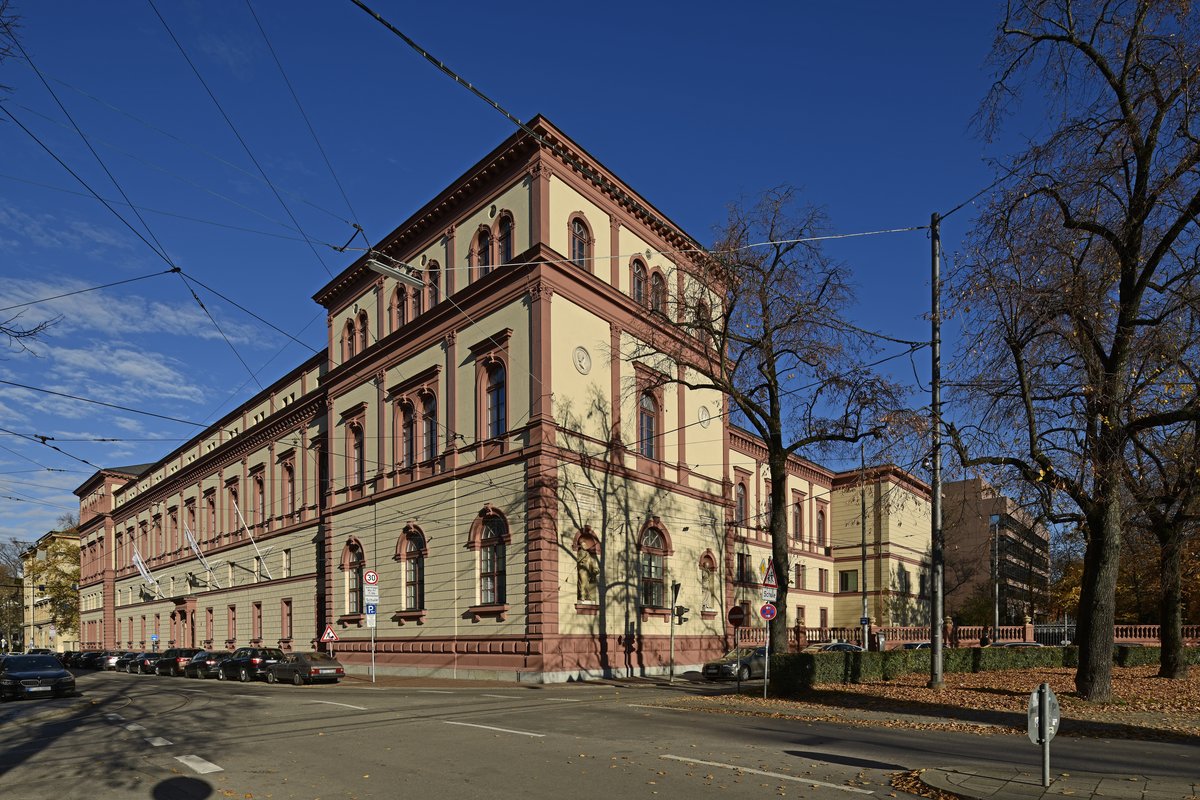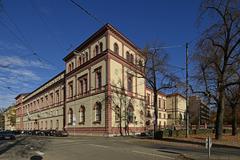
Wilhelmsgymnasium Munich: Visiting Hours, Tickets, and Historical Sites Guide
Date: 14/06/2025
Introduction
Nestled in Munich’s Lehel district, Wilhelmsgymnasium is not only one of Germany’s oldest and most esteemed secondary schools, but also a stunning example of Neo-Renaissance architecture and a living testament to over four centuries of Bavarian intellectual and cultural history. Established in 1559 by Duke Albrecht V of Bavaria, Wilhelmsgymnasium has evolved from its Jesuit origins to become a leading institution in classical education, renowned for its commitment to Latin and Greek studies and its impact on German scholarship and culture. This comprehensive guide covers the school’s history, architectural highlights, notable alumni, and, most importantly, how you can experience this landmark as a visitor—including practical details about visiting hours, tickets, accessibility, and nearby attractions. For the latest updates, event schedules, or guided tour opportunities, always refer to the official Wilhelmsgymnasium website.
Table of Contents
- Historical Overview
- Architectural Significance
- Educational Philosophy
- Role in Bavarian and German History
- Preservation and Modernization
- Visitor Information
- Events and Cultural Activities
- Notable Alumni and Legacy
- Frequently Asked Questions (FAQ)
- Summary Table: Key Visitor Information
- Conclusion
- Sources & Further Reading
Historical Overview
Founded in 1559 by Duke Albrecht V as a Jesuit institution, Wilhelmsgymnasium has been a pillar of classical education in Bavaria for centuries. The school’s curriculum originally emphasized Latin, Greek, philosophy, and theology, consistent with its Counter-Reformation roots. After the suppression of the Jesuits in 1773, Wilhelmsgymnasium became a state-run institution, adapting to secular reforms while maintaining its classical focus. In 1849, the school was renamed in honor of King Wilhelm, coinciding with broader modernization efforts and the construction of its current building. Over the years, Wilhelmsgymnasium has not only weathered political and social upheaval—including the challenges of the Nazi era and postwar reconstruction—but has also remained steadfast in its commitment to humanistic ideals.
Architectural Significance
The current building at Thierschstraße 46, completed in 1879, is a remarkable example of Renaissance Revival (Neo-Renaissance) architecture. Designed by Georg von Hauberrisser and Carl von Leimbach, the structure features:
- A symmetrical stone façade with elaborate cornices, pilasters, and arched windows.
- A rusticated ground floor, classical columns, and a grand central entrance.
- Ornamental details such as stucco, wood paneling, and a central staircase.
- Careful integration with the cityscape of Maximilianstraße and the Maxmonument, reflecting Munich’s 19th-century urban ambitions.
The interior, designed to foster “Ruhe, Raum, Luft, Licht” (tranquility, space, air, light), includes spacious corridors and classrooms, high ceilings, and ample natural light. During the 2015–2018 renovation, these historical features were meticulously restored and modernized (muenchenwiki.de; wilhelmsgymnasium.de).
Educational Philosophy
Wilhelmsgymnasium is one of the few remaining “altsprachliches Gymnasium” (classical grammar schools) in Germany. Its curriculum emphasizes:
- Latin from grade five and Ancient Greek from grade seven.
- Modern languages, mathematics, sciences, philosophy, and the arts.
- A humanistic philosophy that values critical thinking, eloquence, and ethical responsibility.
This educational approach is closely tied to the school’s architectural grandeur, serving as a daily reminder of the ideals of classical scholarship and enlightenment.
Role in Bavarian and German History
Wilhelmsgymnasium has played a pivotal role in shaping Bavarian and German intellectual life. Its alumni have contributed to the Enlightenment, educational reform, literature, music, science, and politics. The school endured significant challenges during the Nazi era, including the expulsion of Jewish students and staff, and underwent denazification and curriculum modernization after World War II. The transition to coeducation in 1977 reflected broader societal changes.
Preservation and Modernization
A protected historical monument, Wilhelmsgymnasium underwent extensive restoration from 2015 to 2018. Key achievements include:
- The careful restoration of the façade, ornamental features, and historic library.
- Upgrades to classrooms, safety, and accessibility standards.
- The addition of a modern sports hall and extra floor, ensuring functionality for future generations.
These efforts highlight the school community’s dedication to preserving its heritage while serving contemporary educational needs (wilhelmsgymnasium.de).
Visitor Information
Visiting Hours and Access
Wilhelmsgymnasium is primarily a functioning school, so public access to its interior is restricted to protect students and staff. However, visitors are welcome to admire the magnificent Neo-Renaissance façade from Thierschstraße and Maximilianstraße at any time.
Tickets and Guided Tours
- Exterior Viewing: Free and available at all times.
- Guided Tours and Special Events: Interior access is possible during public events like the “Tag des offenen Denkmals” (Open Monument Day), annual open houses, or scheduled concerts and exhibitions. These occasions are announced on the official website. Most events are free or require a nominal fee; some may need advance registration.
Accessibility
- The main entrance on Thierschstraße is accessible from street level.
- Recent renovations have improved accessibility, but as a historic building, some interior areas may remain challenging for visitors with mobility impairments.
- For specific accessibility needs, contact the school ahead of your visit.
Travel Tips & Nearby Attractions
- Public Transport: Lehel U-Bahn station (U4/U5), tram lines 16 and 19 (Stop: Maxmonument), and bus lines 100 and 132 serve the area (stadt.muenchen.de).
- Nearby Sights:
- Maxmonument: Directly in front of the school, honoring King Maximilian II.
- Maximilianeum: Home to the Bavarian Parliament (munich.travel).
- Englischer Garten: One of the world’s largest urban parks (munich.travel).
- Altstadt (Old Town): Marienplatz, New Town Hall, and Frauenkirche are a short walk or tram ride away (munich.travel).
- Best Time to Visit: June to mid-September is ideal for exploring the district and enjoying outdoor activities (travellersworldwide.com).
- Parking: Limited; public transport is recommended.
Photography
- Photography of the exterior and surrounding landmarks is welcome.
- Interior photography is generally prohibited except during public events with explicit permission.
Events and Cultural Activities
Wilhelmsgymnasium hosts a range of cultural and academic events throughout the year, including:
- Open House Days: Guided tours, informational sessions, and opportunities to meet faculty and students.
- Concerts and Theater Performances: Often free or with a nominal fee, showcasing the school’s musical and theatrical talents.
- Classical Language Days, Art and Science Fairs, and Public Lectures: Engaging activities that highlight the school’s humanistic and academic traditions.
- Annual School Festival: Features performances, food, and games for the community.
- Collaborations: Events in partnership with local museums and universities.
For event details and schedules, consult the school’s event calendar.
Notable Alumni and Legacy
Wilhelmsgymnasium’s distinguished alumni include:
- Paul Heyse: Nobel laureate writer.
- Carl Orff: Composer.
- Heinrich von Sybel: Historian.
- Jakob Balde, Jakob Bidermann: Neo-Latin poets.
- Franz Xaver Gabelsberger: Inventor of shorthand.
- Max von Pettenkofer: Hygiene pioneer.
- Lion Feuchtwanger, Klaus Mann, Golo Mann: Renowned writers and intellectuals.
The school’s historic library, with its rare early printed works and continuous curation since the Jesuit era, further underscores its contribution to scholarship (wilhelmsgymnasium.de).
Frequently Asked Questions (FAQ)
Q: Can I enter Wilhelmsgymnasium for a tour?
A: Interior access is limited to special events or by prior arrangement. Check the official website for upcoming opportunities.
Q: Is there an admission fee or are tickets required?
A: Viewing the exterior is always free. Some special events or tours may require tickets, with details provided in advance.
Q: Is Wilhelmsgymnasium accessible to people with disabilities?
A: Accessibility has improved after renovations, but some historic areas may still be limited. Contact the school for specific accommodations.
Q: Can I take photographs inside the building?
A: Interior photography is generally not allowed except during special events when permission may be granted.
Q: What other sites can I visit nearby?
A: Maxmonument, Maximilianeum, Englischer Garten, and the Altstadt are all within easy reach.
Summary Table: Key Visitor Information
| Aspect | Details |
|---|---|
| Address | Thierschstraße 46, 80538 München |
| Visiting Hours | No regular hours; exterior accessible anytime; interior access during special events only |
| Tickets | No tickets needed for exterior; special events may require tickets |
| Nearest U-Bahn | Lehel (U4/U5) |
| Nearby Attractions | Maxmonument, Maximilianeum, English Garden, Altstadt |
| Facilities | None for tourists; nearby cafés/restaurants available |
| Website | wilhelmsgymnasium.de |
| Special Events | Open Monument Day, school festivals, concerts, lectures |
| Accessibility | Exterior accessible; interior access limited |
| Contact | +49 89 2121420 |
Conclusion
Wilhelmsgymnasium Munich stands as a beacon of classical education, architectural beauty, and cultural heritage in the heart of Munich. While public access to the interior is generally limited, the school’s grand façade, rich history, and vibrant events make it a rewarding destination for those interested in the city’s intellectual and architectural legacy. Enhance your visit by exploring nearby historical sites and keeping an eye on the school’s event calendar. For expert insights and guided audio tours of Munich’s top landmarks, download the Audiala app.
Sources & Further Reading
- Wilhelmsgymnasium Official Website
- Munich Wiki – Wilhelmsgymnasium
- Stadt München – Wilhelmsgymnasium Info
- Wilhelmsgymnasium Event Calendar
- Wilhelmsgymnasium (Munich) – Wikipedia
- Munich Travel: Maximilianeum, English Garden, Attractions





































































































